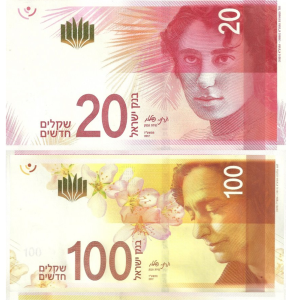The Bank of Israel and the Ministry of Finance appear to have ignored the Law of Unintended Consequences.
 Bnei Brak, December 31 – Researchers have identified a key factor in the economic challenges that face ultra-orthodox Jews in Israel, according to an article published this week, namely that insistence on avoiding depictions of women in the public sphere has led large swaths of the demographic to eschew acceptance or use of two denominations of Israeli currency that feature such images.
Bnei Brak, December 31 – Researchers have identified a key factor in the economic challenges that face ultra-orthodox Jews in Israel, according to an article published this week, namely that insistence on avoiding depictions of women in the public sphere has led large swaths of the demographic to eschew acceptance or use of two denominations of Israeli currency that feature such images.
Economists writing in the latest issue of the journal Fakhnyukt observed that among the country’s Haredim, a significant proportion of the group refuse to pay or accept payment with the 20-shekel and 100-shekel notes, which depict Hebrew poets Rachel Bluwstein and Leah Goldberg, respectively, leading to economic difficulties and added inconvenience in cash transactions.
The researchers noted that a recent downturn in Haredi economic fortunes coincided with the introduction of the Bluwstein-Goldberg notes in 2017, which replaced older currency displaying the likenesses of Prime Minister Moshe Sharett on the 20 and President Itzkah Ben-Tzvi on the 100. The new currency design took place with an eye toward including women in the group of important cultural and political figures in Israel’s history, but, the study warns, produced unintended exacerbation of an already-trying economic situation for almost a sixth of the country’s population.
“The Bank of Israel and the Ministry of Finance appear to have ignored the Law of Unintended Consequences,” the article states, “in failing to take into account a growing tendency in Haredi society to adhere to norms of modesty that minimize or eliminate female imagery. Just as the government makes allowances for cultural or societal sensibilities among, for example, Arab citizens, exempting them from mandatory military service, it could have found a way to feature these women in some other manner, perhaps not on currency. Alternatively, it could have commissioned a design that featured creations of the women but not the women themselves, in keeping with the mores of the affected demographic.”
Lead author Tali Bann of Bar-Ilan University explained in an interview that while alternatives to the 20- and 100-shekel notes exist, they prove cumbersome or inconvenient. “It might only take twice as much space and time to count out two fifties instead of a one-hundred, but first of all, that adds up in time and frustration, and second, that many 50-shekel notes aren’t necessarily available all the time. And when it comes to the twenties, the smallest alternative denomination is the ten-shekel coin, which is a pain to use and to carry around. There’s going to have to be a rethinking of this system.”
Please support our work through Patreon.




